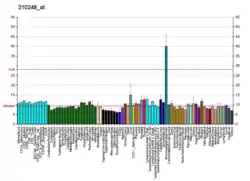WNT7A
Protein Wnt-7a is a protein that in humans is encoded by the WNT7A gene.[5][6][7]
Function
The WNT gene family consists of structurally related genes that encode secreted signaling proteins. These proteins have been implicated in oncogenesis and in several developmental processes, including regulation of cell fate and patterning during embryogenesis. This gene is a member of the WNT gene family. It encodes a protein showing 99% amino acid identity to the mouse Wnt7A protein. This gene not only guides the development of the anterior-posterior axis in the female reproductive tract but also plays a critical role in uterine smooth muscle pattering and maintenance of adult uterine function. It is also responsive to changes in the levels of sex steroid hormone in the female reproductive tract. Decreased expression of this gene in human uterine leiomyoma is found to be inversely associated with the expression of estrogen receptor alpha.[7]
References
- GRCh38: Ensembl release 89: ENSG00000154764 - Ensembl, May 2017
- GRCm38: Ensembl release 89: ENSMUSG00000030093 - Ensembl, May 2017
- "Human PubMed Reference:". National Center for Biotechnology Information, U.S. National Library of Medicine.
- "Mouse PubMed Reference:". National Center for Biotechnology Information, U.S. National Library of Medicine.
- Ikegawa S, Kumano Y, Okui K, Fujiwara T, Takahashi E, Nakamura Y (Dec 1996). "Isolation, characterization and chromosomal assignment of the human WNT7A gene". Cytogenet Cell Genet. 74 (1–2): 149–52. doi:10.1159/000134404. PMID 8893824.
- Bui TD, Lako M, Lejeune S, Curtis AR, Strachan T, Lindsay S, Harris AL (Jun 1997). "Isolation of a full-length human WNT7A gene implicated in limb development and cell transformation, and mapping to chromosome 3p25". Gene. 189 (1): 25–9. doi:10.1016/S0378-1119(96)00808-6. PMID 9161407.
- "Entrez Gene: WNT7A wingless-type MMTV integration site family, member 7A".
Further reading
- Smolich BD, McMahon JA, McMahon AP, Papkoff J (1994). "Wnt family proteins are secreted and associated with the cell surface". Mol. Biol. Cell. 4 (12): 1267–75. doi:10.1091/mbc.4.12.1267. PMC 275763. PMID 8167409.
- Huguet EL, McMahon JA, McMahon AP, et al. (1994). "Differential expression of human Wnt genes 2, 3, 4, and 7B in human breast cell lines and normal and disease states of human breast tissue". Cancer Res. 54 (10): 2615–21. PMID 8168088.
- Parr BA, McMahon AP (1998). "Sexually dimorphic development of the mammalian reproductive tract requires Wnt-7a". Nature. 395 (6703): 707–10. Bibcode:1998Natur.395..707P. doi:10.1038/27221. PMID 9790192. S2CID 4423065.
- Calvo R, West J, Franklin W, et al. (2001). "Altered HOX and WNT7A expression in human lung cancer". Proc. Natl. Acad. Sci. U.S.A. 97 (23): 12776–81. doi:10.1073/pnas.97.23.12776. PMC 18840. PMID 11070089.
- Li S, Chiang TC, Davis GR, et al. (2001). "Decreased expression of Wnt7a mRNA is inversely associated with the expression of estrogen receptor-alpha in human uterine leiomyoma". J. Clin. Endocrinol. Metab. 86 (1): 454–7. doi:10.1210/jc.86.1.454. PMID 11232041.
- Couse JF, Dixon D, Yates M, et al. (2002). "Estrogen receptor-alpha knockout mice exhibit resistance to the developmental effects of neonatal diethylstilbestrol exposure on the female reproductive tract". Dev. Biol. 238 (2): 224–38. doi:10.1006/dbio.2001.0413. PMID 11784006.
- Strausberg RL, Feingold EA, Grouse LH, et al. (2003). "Generation and initial analysis of more than 15,000 full-length human and mouse cDNA sequences". Proc. Natl. Acad. Sci. U.S.A. 99 (26): 16899–903. Bibcode:2002PNAS...9916899M. doi:10.1073/pnas.242603899. PMC 139241. PMID 12477932.
- Caricasole A, Ferraro T, Iacovelli L, et al. (2003). "Functional characterization of WNT7A signaling in PC12 cells: interaction with A FZD5 x LRP6 receptor complex and modulation by Dickkopf proteins". J. Biol. Chem. 278 (39): 37024–31. doi:10.1074/jbc.M300191200. PMID 12857724.
- Tuli R, Tuli S, Nandi S, et al. (2003). "Transforming growth factor-beta-mediated chondrogenesis of human mesenchymal progenitor cells involves N-cadherin and mitogen-activated protein kinase and Wnt signaling cross-talk". J. Biol. Chem. 278 (42): 41227–36. doi:10.1074/jbc.M305312200. PMID 12893825.
- Ohira T, Gemmill RM, Ferguson K, et al. (2003). "WNT7a induces E-cadherin in lung cancer cells". Proc. Natl. Acad. Sci. U.S.A. 100 (18): 10429–34. Bibcode:2003PNAS..10010429O. doi:10.1073/pnas.1734137100. PMC 193578. PMID 12937339.
- Timmreck LS, Pan HA, Reindollar RH, Gray MR (2004). "WNT7A mutations in patients with Müllerian duct abnormalities". Journal of Pediatric and Adolescent Gynecology. 16 (4): 217–21. doi:10.1016/S1083-3188(03)00124-4. PMID 14550385.
- Hwang SG, Ryu JH, Kim IC, et al. (2004). "Wnt-7a causes loss of differentiated phenotype and inhibits apoptosis of articular chondrocytes via different mechanisms". J. Biol. Chem. 279 (25): 26597–604. doi:10.1074/jbc.M401401200. PMID 15082716.
- Winn RA, Marek L, Han SY, et al. (2005). "Restoration of Wnt-7a expression reverses non-small cell lung cancer cellular transformation through frizzled-9-mediated growth inhibition and promotion of cell differentiation". J. Biol. Chem. 280 (20): 19625–34. doi:10.1074/jbc.M409392200. PMID 15705594.
- Lyu J, Joo CK (2005). "Wnt-7a up-regulates matrix metalloproteinase-12 expression and promotes cell proliferation in corneal epithelial cells during wound healing". J. Biol. Chem. 280 (22): 21653–60. doi:10.1074/jbc.M500374200. PMID 15802269.
- Woods CG, Stricker S, Seemann P, et al. (2006). "Mutations in WNT7A Cause a Range of Limb Malformations, Including Fuhrmann Syndrome and Al-Awadi/Raas-Rothschild/Schinzel Phocomelia Syndrome". Am. J. Hum. Genet. 79 (2): 402–8. doi:10.1086/506332. PMC 1559483. PMID 16826533.
- Winn RA, Van Scoyk M, Hammond M, et al. (2006). "Antitumorigenic effect of Wnt 7a and Fzd 9 in non-small cell lung cancer cells is mediated through ERK-5-dependent activation of peroxisome proliferator-activated receptor gamma". J. Biol. Chem. 281 (37): 26943–50. doi:10.1074/jbc.M604145200. PMID 16835228.
- Lindberg D, Akerström G, Westin G (2007). "Mutational analyses of WNT7A and HDAC11 as candidate tumour suppressor genes in sporadic malignant pancreatic endocrine tumours". Clin. Endocrinol. 66 (1): 110–4. doi:10.1111/j.1365-2265.2006.02694.x. PMID 17201809. S2CID 21975021.
- Thrasivoulou C, Millar M, Ahmed A (2013). "Activation of intracellular calcium by multiple Wnt ligands and translocation of ß-catenin into the nucleus: a convergent model of Wnt/Ca2+ and Wnt/ß-catenin pathways". J. Biol. Chem. 288 (50): 35651–35659. doi:10.1074/jbc.M112.437913. PMC 3861617. PMID 24158438.




